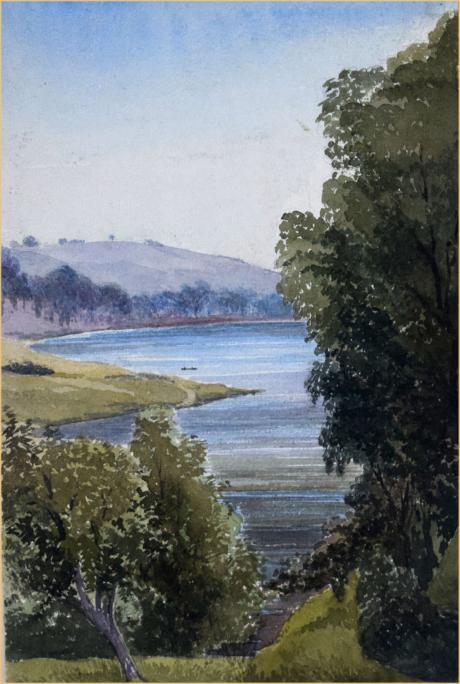inscribed and dated in the margin "The Tweed from Wark, Northumberland Sept 11th 1878"
Wark or Wark on Tweed is a village in the English county of Northumberland. It lies about 15 mi (24 km) south west of Berwick-upon-Tweed.
It is on the south bank of the River Tweed, which marks the border between England and Scotland. The ruins of Wark on Tweed Castle, originally an early 12th-century motte-and-bailey, lie at the west end of the village. The border between Scotland and England runs down the middle of the River Tweed, but between the villages of Wark and Cornhill, the Scottish border comes south of the river to enclose a small riverside meadow around 2 acres (0.81 hectares) to 3 acres (1.2 hectares). This piece of land is known as the Ba Green. It is said locally that every year the men of Coldstream (to the north of the river) would play the men of Wark at ba, and the winning side would claim the Ba Green for their country. As Coldstream grew to have a larger population than Wark, the Coldstream men always defeated the Wark men at the game, so the land became a permanent part of Scotland.
Wark Castle was severely damaged by King John in 1215, was rebuilt, then damaged again in subsequent conflict. Legend says that the Order of the Garter was established at Wark during a stay by Edward III in 1348. The story goes that the king gave a ball to celebrate his defeat of the Scots in battle.During the ball the Countess of Salisbury dropped her garter, causing some courtiers to snigger. The king swiftly gathered up the garter and fixed it to his own leg, uttering the words that became the motto of the Order; 'honi soit qui mal y pense' (shame on he who thinks evil of it).
The castle stands on a natural mound called a kaim, formed by glacial deposit, looking down on the River Tweed. The castle motte is overgrown, with only remnants of stone walls standing. Most of the present village of Wark stands within the original castle bailey, or defensive enclosure. It is freely accessible and is located on the western edge of the village, directly off the B6350. There are no signs to the castle, but you can't miss the high motte. The importance of Wark at a vital crossing of the Tweed led to it being granted a weekly market and an annual fair. Until the 19th century most of the residents worked at fishing, but in the late Victorian era coal and lime mining grew in importance, and after the railway arrived agricultural labouring grew in importance. The most famous native of Wark was poet Robert Story, born here in 1795. Story, known as 'The Craven Poet', was the son of a farm labourer and worked as a gardener and shepherd before embarking on a career as a teacher. He worked as a minor civil servant in London before his poetry drew the attention of the Duke of Northumberland, who acted as his patron and financed the publication of his works.


